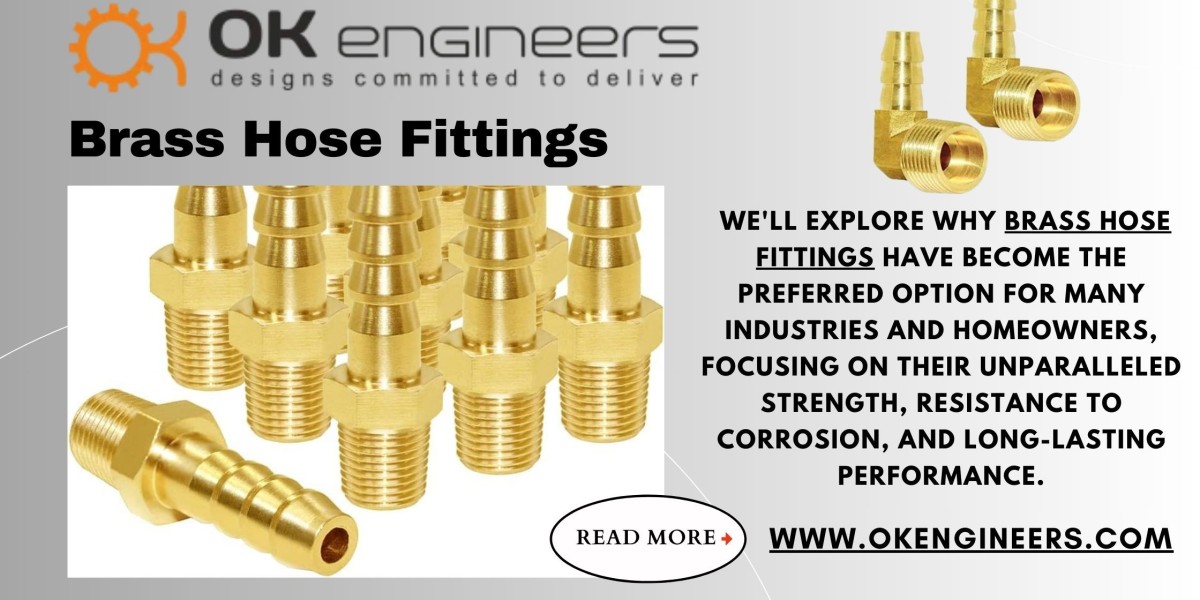When it comes to securing a reliable and leak-free connection for your hoses, Brass Hose Fittings are the ultimate solution. Whether you're dealing with garden hoses, automotive applications, or industrial settings, brass has long been the preferred material for fittings due to its durability, corrosion resistance, and excellent sealing capabilities. In this blog, we'll take an in-depth look at Brass Hose Fittings and uncover why they are the secret to creating leak-free connections in any setting.
We’ll also explore the different types of fittings, their advantages, and how to select the right one for your specific needs.
What Are Brass Hose Fittings?
Brass hose fittings are small yet crucial components that connect hoses to a wide range of devices such as sprinklers, faucets, pumps, or other hoses. These fittings are designed to ensure a tight seal and prevent leakage at the junction where the hose meets the connecting hardware. Brass is a strong, versatile material that can withstand high pressure and adverse conditions, making it perfect for both residential and commercial applications.
Key Components of a Brass Hose Fitting
A brass hose fitting typically consists of three main parts:
- Hose Barb: This part slides into the hose and grips the interior of the hose for a tight connection.
- Body: The main structure that houses the threads or connections.
- Nut or Clamp: Ensures that the fitting remains securely attached to the hose and device. Depending on the type of fitting, some may include threaded nuts or clamps to hold the hose in place.
Types of Brass Hose Fittings
There are various types of Brass Hose Fittings available, each serving a specific purpose and designed for different applications. Here's an overview of the most common types:
Male and Female Hose Fittings:
- Male Fittings have external threads and connect to a female-threaded component, like a faucet.
- Female Fittings have internal threads and connect to male-threaded parts like nozzles or other hoses.
- These are commonly used for garden hoses and can be easily connected and disconnected as needed.
Quick-Connect Fittings:
- Quick-connect fittings offer a convenient way to attach and detach hoses without twisting and turning the parts. They use a snap-fit mechanism to secure the connection.
- Ideal for applications where speed and convenience are essential, such as in garden watering systems or automotive setups.
Barbed Fittings:
- Barbed fittings are commonly used when a firm, tight grip is needed on the hose. The barb end is inserted into the hose, and the design ensures a secure fit.
- These are frequently used in air, water, and fuel systems.
Compression Fittings:
- Compression fittings use a threaded sleeve or nut to press down on the hose, creating a tight seal. These are used in situations where you need a leak-free connection without soldering or welding.
Swivel Fittings:
- Swivel fittings allow rotation even after the connection has been made, preventing the hose from tangling or twisting during operation. This flexibility is especially useful in applications where hoses are frequently moved.
Elbow and Tee Fittings:
- Elbow Fittings are designed to change the direction of the hose, usually by 90 degrees.
- Tee Fittings split the flow into two directions, allowing you to divert water or fluid into two different areas.
Why Brass Is the Preferred Material for Hose Fittings
Brass has unique properties that make it an ideal material for hose fittings. It outperforms many other materials in terms of durability, corrosion resistance, and overall functionality.
1. Corrosion Resistance
Brass naturally resists corrosion, which is crucial in applications where fittings are exposed to water, moisture, or chemicals. Unlike steel, which can rust, brass maintains its integrity over time, ensuring long-lasting performance. This makes it the best option for both indoor and outdoor use, where environmental factors can quickly degrade other materials.
2. Strength and Durability
Brass is exceptionally strong and capable of withstanding high pressures, which is essential for applications such as irrigation, hydraulic systems, and gas lines. Additionally, it is less prone to cracking or breaking, even in harsh conditions or extreme temperatures. This makes brass hose fittings a highly reliable choice in industrial and heavy-duty settings.
3. Thermal Conductivity
Brass has excellent thermal conductivity, making it ideal for fittings used in hot water or heating systems. It can handle high temperatures without deforming or weakening, ensuring a safe and efficient operation.
4. Leak-Resistant Properties
One of the primary concerns when dealing with hose connections is leakage. Brass hose fittings are specifically designed to create tight, leak-proof connections. The material’s ability to form precise threads ensures that no gaps are left for fluid to escape, making it ideal for pressurized systems.
5. Compatibility with Various Fluids
Brass is compatible with a wide range of fluids, including water, air, oil, and gas. This versatility makes it useful in numerous applications, from residential plumbing to industrial gas lines. It is also resistant to the buildup of mineral deposits, ensuring smooth, consistent flow over time.
Common Applications of Brass Hose Fittings
Brass hose fittings are incredibly versatile and can be used in a variety of industries and applications. Some of the most common uses include:
1. Garden and Lawn Care
In home gardening and landscaping, brass hose fittings are commonly used for connecting garden hoses to sprinklers, nozzles, and faucets. The durability and corrosion resistance of brass ensure that these fittings can handle outdoor exposure, including rain and sun, without deteriorating.
2. Automotive Industry
In automotive applications, brass hose fittings are used for fuel lines, air brakes, and cooling systems. The fittings' ability to handle high-pressure and temperature conditions ensures that automotive systems run safely and efficiently.
3. Plumbing Systems
Brass fittings are frequently used in plumbing systems to connect water pipes, faucets, and appliances such as dishwashers and washing machines. Their corrosion resistance and strength make them suitable for both hot and cold water systems.
4. Industrial and Hydraulic Applications
In industrial settings, brass hose fittings are used for air compressors, hydraulic machinery, and pneumatic systems. These fittings are essential in ensuring that equipment functions safely under pressure without leaks.
How to Choose the Right Brass Hose Fitting
Selecting the right brass hose fitting depends on several factors, including the type of application, the hose diameter, and the type of fluid being used. Here are some key considerations:
1. Hose Diameter
Ensure that the fitting matches the diameter of the hose. A mismatch can lead to a poor fit, causing leaks or the connection to fail altogether.
2. Thread Type
Pay attention to the thread type (e.g., BSP, NPT) on the fittings to ensure compatibility with your existing equipment. The wrong thread type can lead to stripped threads, poor seals, and leaks.
3. Pressure Rating
Make sure the fitting can handle the pressure of the fluid system. Check the pressure rating on the fitting and compare it to the system's maximum operating pressure to avoid accidents or damage.
4. Fluid Type
Consider the type of fluid flowing through the system. For example, fittings used for fuel systems may need different coatings or treatments to resist chemical corrosion.
Maintaining Your Brass Hose Fittings
To ensure the longevity of your Brass Hose Fittings, follow these maintenance tips:
- Regular Inspection: Periodically check for signs of wear, corrosion, or leaks. Replace damaged fittings immediately to avoid system failure.
- Tighten Connections: Over time, connections can loosen due to vibration or thermal expansion. Regularly check and tighten connections to prevent leaks.
- Clean Threads: Dirt and debris can accumulate on the threads of the fitting, compromising the seal. Clean the threads regularly to ensure a secure connection.
Conclusion
Brass Hose Fittings are the secret to leak-free, reliable connections across a wide range of applications, from residential garden hoses to high-pressure industrial systems. Their corrosion resistance, strength, and versatility make them the preferred choice for professionals and DIY enthusiasts alike.
For those looking to invest in high-quality, durable hose fittings, brass is the best option available. At Brass Hose Fittings, we offer a wide range of Brass Hose Fittings designed to meet your specific needs. Whether you're a homeowner looking for garden hose solutions or an industry professional in need of durable fittings, you can trust our products to provide long-lasting, leak-free performance.
Choose brass, and secure the reliability you need for your hose connections!









